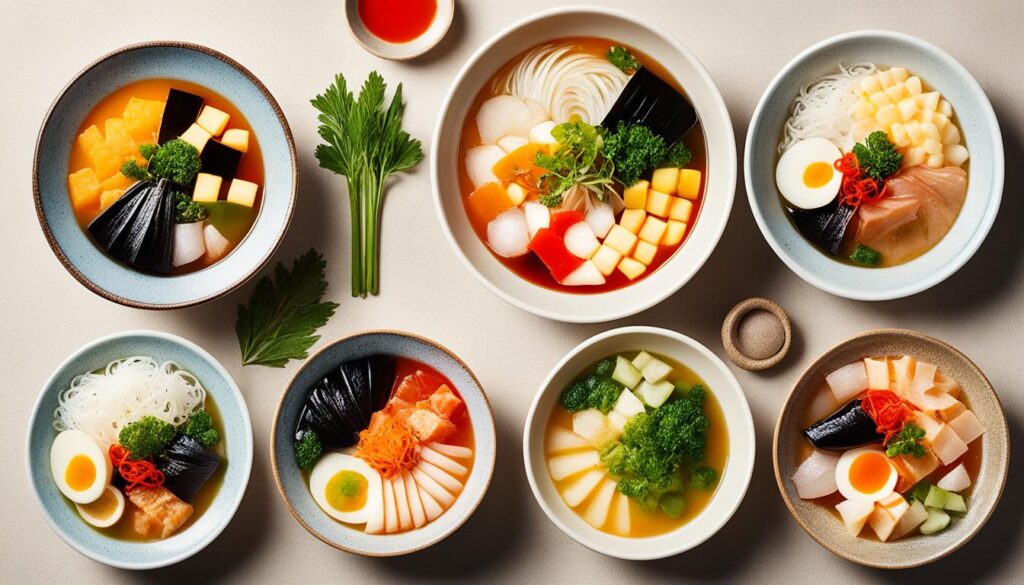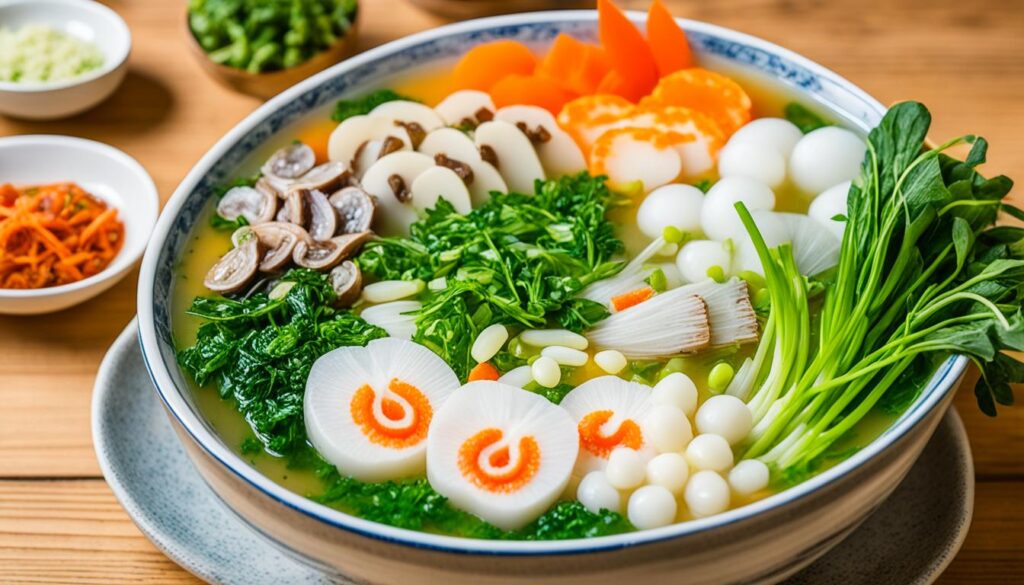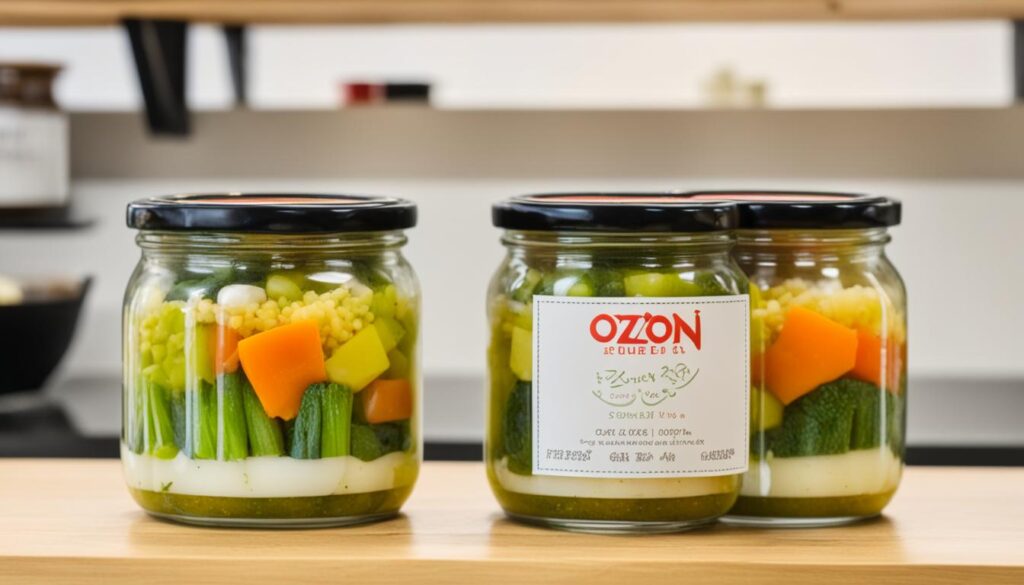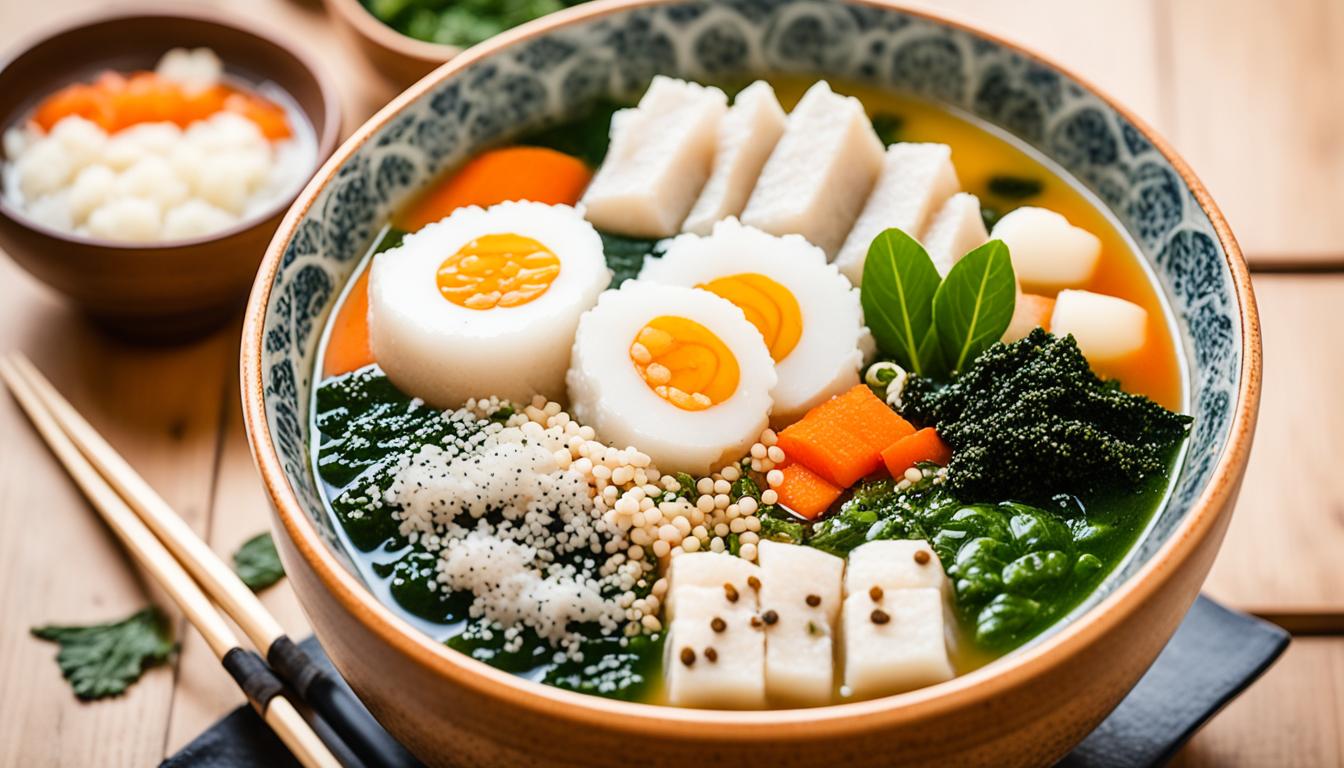Are you intrigued by the idea of starting the New Year with a warm and comforting bowl of soup? Introducing… traditional Ozoni! A delicious Japanese soup that is enjoyed as a breakfast dish on New Year’s Day. This delightful soup is packed with flavors and symbols that hold deep cultural significance in Japan. So, what makes this soup so special? Let’s unravel the secrets of Ozoni as we dive into its traditional recipe, ingredients, and the heartwarming stories behind it.
The Significance of Ozoni in Japanese Culture
Ozoni holds a significant place in Japanese culture, particularly during the New Year celebration. It is a cherished tradition that has been passed down through generations, symbolizing hope, luck, and prosperity for the coming year.
The cultural importance of ozoni lies not only in its delicious flavors but also in its symbolic meaning. The round shape of the mochi, a key ingredient in ozoni, represents harmony and completeness. This shape is believed to bring a sense of unity and togetherness to the family, fostering strong bonds and a sense of belonging.
“Eating ozoni on New Year’s Day is believed to bring good luck and ensure a prosperous year ahead.”
Apart from its shape, the various ingredients used in ozoni also hold significance. Each ingredient represents a different aspect of good fortune. For example, carrots symbolize wealth, daikon radish represents happiness, and spinach signifies vitality and rejuvenation. These ingredients, combined in a warm and comforting soup, create a harmonious blend of flavors and blessings.
It’s important to note that ozoni is not just a dish for the New Year celebration, but also an opportunity for families to come together and honor their cultural traditions. The preparation and serving of ozoni is often a collaborative effort, with everyone playing a role in creating a delicious and auspicious start to the year.
Preserving Cultural Heritage
Ozoni soup serves as a reminder of the rich cultural heritage of Japan, highlighting the importance of traditions in modern society. By continuing to prepare and enjoy ozoni, Japanese families keep their customs alive and pass them down to future generations.
Furthermore, ozoni showcases the value placed on food as a way to express gratitude and bring people together. It is a reflection of the Japanese concept of “itadakimasu,” which expresses appreciation for the hard work that goes into growing and preparing food.
Overall, ozoni is more than just a traditional New Year’s dish; it is a symbol of cultural identity, unity, and good fortune. By partaking in this age-old tradition, individuals can connect with their roots, embrace the spirit of the New Year, and savor the flavors that have been treasured for centuries.
Differences Between Kanto and Kansai Style Ozoni
Kanto style ozoni and Kansai style ozoni are two distinct variations of this beloved Japanese dish. The region-specific differences in broth and ingredients create unique flavors and culinary experiences.
Kanto Style Ozoni
In the Kanto region, which includes Tokyo, Kanto style ozoni is characterized by its clear dashi-based broth made with fish stock and soy sauce. This savory broth forms the foundation of the dish and complements the other ingredients.
Kanto style ozoni often includes chicken as one of its key ingredients, adding a meaty richness to the soup. The use of chicken in the broth provides a savory depth of flavor that pairs well with the other components of the dish.
Kansai Style Ozoni
In the Kansai region, particularly in Kyoto, Kansai style ozoni showcases a miso-based broth. The miso broth is typically made with Saikyo miso, a sweet white miso unique to the area. The sweetness of Saikyo miso enhances the overall flavor of the soup, giving it a delightful balance.
Kansai style ozoni emphasizes the use of taro root, daikon radish, and Kyoto-style carrot as its primary ingredients. These vegetables lend a hearty and earthy element to the dish, creating a satisfying bowl of soup.
Differences Between Kanto and Kansai Style Ozoni
| Kanto Style Ozoni | Kansai Style Ozoni |
|---|---|
| Clear dashi-based broth | Miso-based broth, often with Saikyo miso |
| Incorporates chicken | Uses taro root, daikon radish, and Kyoto-style carrot |
| Distinct savory flavor | Delightful balance of sweetness |
Both Kanto style ozoni and Kansai style ozoni offer their own unique take on this traditional dish. Whether you prefer the clear, savory broth of Kanto or the sweet complexity of Kansai, both styles are a delicious representation of their respective regions.

Ingredients for Traditional Ozoni Soup
Traditional ozoni soup is made with a combination of key ingredients that contribute to its rich and flavorful taste. The essential ingredients for ozoni include:
- Mochi: A type of sticky rice cake that adds a chewy texture to the soup.
- Dashi: A flavorful broth made from kombu (dried kelp) or bonito flakes, used as the base for the soup.
- Vegetables: Common vegetables used in ozoni include carrots, daikon radish, aburaage (fried tofu skins), and spinach. These vegetables add freshness and color to the soup.
- Protein: Depending on preference and regional variations, ozoni can include protein such as chicken, fish, or shrimp. This adds depth of flavor and makes the soup more filling.
- Soy sauce or miso: These seasonings add savory umami flavors to the soup and enhance the overall taste.
- Scallions: Finely chopped scallions are often used as a garnish to provide a subtle onion flavor and a pop of green color.
These ingredients come together to create a harmonious balance of flavors and textures in traditional ozoni soup. The combination of the chewy mochi, flavorful broth, fresh vegetables, protein, and seasonings makes this soup a delicious and comforting dish to enjoy during the New Year celebration.
Cooking is an art that brings people together. With the essential ingredients for ozoni soup, you can create a traditional dish that not only satisfies the taste buds but also captures the spirit of Japanese culture and heritage. The rich flavors and symbolic elements of ozoni make it a beloved dish during the New Year’s festivities. So, gather your ingredients and embark on a culinary journey that celebrates tradition and togetherness.
Step-by-Step Instructions for Making Traditional Ozoni Soup
Making homemade ozoni soup is a delightful way to celebrate the New Year and enjoy the rich flavors of Japanese cuisine. Follow these step-by-step instructions to create a delicious and authentic batch of ozoni:
- Prepare the broth:
To make the flavorful base for your ozoni soup, you can choose between a clear dashi-based broth or a miso-based broth. Here, we will provide instructions for both options:
Clear Dashi-based Broth:
- In a large pot, combine 6 cups of water and 2 pieces of kombu (kelp).
- Bring the water to a simmer over medium heat and remove the kombu.
- Add 1 cup of bonito flakes to the pot and simmer for another 5 minutes.
- Strain the broth to remove any solids and set it aside.
Miso-based Broth:
- In a separate pot, combine 6 cups of water and 3 tablespoons of miso paste.
- Bring the water to a gentle simmer, stirring until the miso is fully dissolved.
- Remove the pot from heat and set the miso broth aside.
- Prepare the ingredients:
While the broth simmers, gather the traditional ozoni ingredients:
- 4 pieces of mochi (rice cakes)
- 1 carrot, sliced
- 1 daikon radish, sliced
- 2 aburaage (fried tofu skins), cut into rectangles
- A handful of spinach leaves
- 4 shiitake mushrooms, sliced
- 1 green onion, finely chopped
- Cook the ingredients:
Here’s how to cook the ingredients for your homemade ozoni soup:
“Ozoni: a traditional Japanese New Year’s soup with a delicious combination of ingredients.”
Preparing the Mochi:
- Place the mochi in a pan of boiling water and cook until it becomes soft and chewy.
- Remove the mochi from the water and set it aside.
Cooking the Vegetables:
- In a separate pot, bring water to a boil and blanch the carrot, daikon radish, aburaage, and spinach for a few minutes until slightly tender.
- Remove the vegetables from the pot and set them aside.
- Assemble the ozoni soup:
Now it’s time to bring all the elements together to create your homemade ozoni soup:
- Place the cooked mochi, vegetables, shiitake mushrooms, and green onion in individual serving bowls.
- Gently pour the prepared broth (dashi-based or miso-based) over the ingredients in each bowl.

- Serve and enjoy:
Your homemade ozoni soup is now ready to be enjoyed. Serve it hot and savor the flavors of this traditional Japanese New Year’s dish.
| Step | Instructions |
|---|---|
| 1 | Prepare the broth |
| a. Clear Dashi-based Broth: Combine water and kombu, simmer, add bonito flakes, strain. | |
| b. Miso-based Broth: Combine water and miso paste, simmer until dissolved. | |
| 2 | Prepare the ingredients |
| 3 | Cook the ingredients |
| a. Preparing the Mochi: Boil mochi until soft and chewy, set aside. | |
| b. Cooking the Vegetables: Blanch carrot, daikon radish, aburaage, and spinach, set aside. | |
| 4 | Assemble the ozoni soup |
| 5 | Serve and enjoy |
Tips for Serving and Storing Ozoni Soup
Ozoni soup is a delightful dish that is best enjoyed fresh, allowing the flavors and textures to shine. However, if you find yourself with leftovers or want to prepare ozoni in advance, here are some tips to ensure you can still enjoy its deliciousness:
Serving Ozoni:
- When serving ozoni, it is important to have all the components at their best. Gently reheat the broth to retain its flavors and warmth. This will ensure that the soup maintains its comforting appeal.
- Arrange the ozoni ingredients beautifully in each bowl to create an appetizing presentation. Place the mochi, vegetables, and any other additions in an organized and visually appealing manner.
- Consider garnishing your ozoni with finely sliced green onions or a sprinkle of toasted sesame seeds for added flavor and aesthetic appeal.
Storing Ozoni Soup:
- If you have leftover ozoni soup, store it in an airtight container in the refrigerator. The broth may absorb the flavors of the ingredients and become even tastier over time.
- Separate the mochi from the broth and vegetables before storing. This will prevent the mochi from becoming too soft and losing its texture.
- When ready to enjoy the leftover ozoni, gently reheat the broth and add the mochi and vegetables just before serving to ensure they remain tender and flavorful.

With these serving and storing tips, you can savor the deliciousness of ozoni soup even beyond its initial serving. Whether enjoyed fresh or reheated, ozoni is a comforting and flavorful dish that embodies the traditions and warmth of the Japanese New Year celebration.
Variations and Regional Adaptations of Ozoni Soup
Ozoni soup is a dish that varies across different regions of Japan, with each area adding its own unique twists to the traditional recipe. Whether it’s a change in broth, ingredients, or cooking methods, regional ozoni variations and adaptations offer delightful flavors and showcase the diverse culinary heritage of Japan. Here are a few examples of unique ozoni recipes:
Ozoni with Kamaboko in Hiroshima
In Hiroshima, ozoni features kamaboko, a traditional Japanese fish cake made from pureed white fish. This adds a subtle sweetness to the soup, complementing the savory flavors of the broth and other ingredients.
Iwate’s Ozoni with Clams
In Iwate prefecture, clams take center stage in the ozoni soup. The briny flavor of the clams enhances the overall taste, creating a unique and refreshing variation of this traditional dish.
Kyoto-style Vegetarian Ozoni
In Kyoto, where Buddhist traditions have influenced the local cuisine, a vegetarian version of ozoni is popular. This variation replaces meat with seasonal vegetables, such as Kyoto-style carrot, and features a miso-based broth that is subtly sweet and rich in umami.
These are just a few examples of the many regional ozoni variations found throughout Japan. Each adaptation showcases the culinary creativity and local preferences of its respective area, offering a diverse and delicious array of ozoni soups to enjoy.
| Region | Variation |
|---|---|
| Hiroshima | Ozoni with Kamaboko |
| Iwate | Ozoni with Clams |
| Kyoto | Vegetarian Ozoni |
Cultural Significance and Symbolism of Ozoni
Ozoni holds great cultural significance in Japan, particularly during the New Year’s celebration. It is deeply rooted in tradition and is considered a symbol of good fortune, longevity, and the harvest season.
The round shape of the mochi in ozoni represents harmony and completeness. The mochi, made from pounded rice, is believed to bring unity and togetherness to families as they gather around the table to enjoy the dish. This symbolism reflects the importance of family and community bonds during the New Year festivities.
Beyond its shape, the ingredients used in ozoni also carry symbolic meanings. Each ingredient represents different aspects of luck and prosperity. For example, carrots symbolize good health, daikon radish represents fertility, and aburaage (fried tofu skins) signify happiness and wealth.
Ozoni is not only a delicious soup but also a way to honor tradition and bring blessings for the coming year. It embodies the cultural values of Japanese society and serves as a reminder of the importance of gratitude, unity, and hope for the future. By partaking in this cherished New Year’s tradition, families believe they are inviting positive energy and harmony into their lives.
To visually capture the essence of ozoni, take a look at the image below:
Whether you are celebrating the New Year in Japan or embracing the cultural traditions from afar, ozoni serves as a tangible representation of the country’s rich heritage and the values it holds dear. It is more than just a soup; it is a delicious embodiment of good wishes and the collective hopes for a prosperous year ahead.
Health Benefits of Ozoni Ingredients
Ozoni soup is not only a flavorful dish but also offers various health benefits. The combination of ingredients in ozoni makes it a nourishing and wholesome choice for a meal. Let’s take a closer look at some of the key ingredients in ozoni and their potential health benefits.
Mochi
Mochi, the chewy rice cake found in ozoni, is made from glutinous rice. It is a good source of carbohydrates and provides energy to fuel your day. Mochi is also gluten-free, making it suitable for individuals with celiac disease or gluten sensitivities.
Dashi Broth
The dashi broth in ozoni is traditionally made from kombu (dried kelp) and bonito flakes (dried skipjack tuna). Kombu is rich in iodine, which is essential for maintaining a healthy thyroid function. Bonito flakes are packed with protein and contain omega-3 fatty acids that support heart health.
Vegetables
Ozoni typically includes an assortment of vegetables such as carrots, daikon radish, and spinach. These vegetables are low in calories and high in fiber, vitamins, and minerals. Carrots are an excellent source of vitamin A and beta-carotene, which are beneficial for eye health. Daikon radish is known for its detoxifying properties and is a good source of vitamin C. Spinach is packed with iron, calcium, and antioxidants that promote overall health and well-being.
Chicken (Kanto Style) / Taro Root (Kansai Style)
In Kanto-style ozoni, chicken is often added to the soup. Chicken is a great source of lean protein and essential amino acids that support muscle growth and repair. Taro root, commonly used in Kansai-style ozoni, is a starchy vegetable that provides dietary fiber and has a high potassium content, which contributes to a healthy heart and blood pressure.
Aburaage (Fried Tofu Skins)
Aburaage, a common ingredient in ozoni, is made from tofu skins that have been deep-fried. It adds a savory and chewy texture to the soup. Tofu is a plant-based protein source that is rich in calcium and low in saturated fat. It also contains isoflavones, which are thought to have various health benefits, including reducing the risk of heart disease.
| Ingredient | Potential Health Benefits |
|---|---|
| Mochi | Good source of carbohydrates; gluten-free |
| Dashi Broth | Iodine-rich; contains omega-3 fatty acids |
| Vegetables | Low in calories; high in fiber, vitamins, and minerals |
| Chicken (Kanto Style) / Taro Root (Kansai Style) | Lean protein; potassium-rich |
| Aburaage | Plant-based protein; rich in calcium and isoflavones |
As you can see, ozoni is not only a delicious dish but also a nourishing choice that provides essential nutrients for your overall well-being. Incorporating ozoni into your diet can be a great way to enjoy a traditional Japanese meal while reaping the health benefits of its ingredients.
Ozoni Soup Recipe Variations for Dietary Restrictions
Ozoni soup is a versatile dish that can easily be adapted to accommodate different dietary restrictions and preferences. Whether you follow a vegan, gluten-free, or vegetarian diet, there are variations of ozoni that you can enjoy. Here are some recipe ideas for different dietary needs:
Vegan Ozoni Soup
For those following a vegan diet, you can make a delicious vegan version of ozoni by substituting animal-based ingredients with plant-based alternatives. Here’s a vegan ozoni soup recipe:
- Use vegetable broth or kombu dashi as the base for the soup instead of traditional fish-based dashi.
- Replace the traditional protein sources like chicken or fish with tofu or tempeh.
- Include a variety of vegetables like carrots, daikon radish, mushrooms, and spinach.
- Make sure to use vegan-friendly mochi made with rice flour.
- Season the soup with soy sauce or tamari for added flavor.
Gluten-Free Ozoni Recipe
If you have a gluten intolerance or follow a gluten-free diet, you can still enjoy ozoni by making a few simple substitutions. Here’s a gluten-free ozoni soup recipe:
- Ensure that all the ingredients, including the dashi, miso paste, and soy sauce, are certified gluten-free.
- Choose gluten-free mochi made from rice flour or other gluten-free grains.
- Replace any wheat-based ingredients like udon noodles with gluten-free alternatives like rice or soba noodles.
Vegetarian Ozoni Variation
For those who don’t consume meat but still eat dairy and eggs, a vegetarian version of ozoni can be made by modifying the traditional recipe. Here’s a vegetarian ozoni variation:
- Use vegetable broth or kombu dashi as the base for the soup.
- Include a variety of vegetables like carrots, daikon radish, mushrooms, and spinach.
- Instead of using animal-based protein sources, you can add boiled eggs or grated cheese for additional flavor and richness.
- Ensure that the mochi you use is free from any animal products.
By adapting the recipe to suit your dietary needs, you can still enjoy the comforting and flavorful ozoni soup while staying true to your food choices. Remember to use high-quality, fresh ingredients to enhance the taste and nutritional value of your homemade ozoni.
Ozoni Soup Recipe Variations for Dietary Restrictions
| Dietary Restriction | Recipe Modification |
|---|---|
| Vegan | Use vegetable broth or kombu dashi. Substitute chicken or fish with tofu or tempeh. Opt for vegan-friendly mochi. Season with soy sauce or tamari. |
| Gluten-Free | Ensure all ingredients are gluten-free. Choose gluten-free mochi and noodles. |
| Vegetarian | Use vegetable broth or kombu dashi. Include a variety of vegetables. Replace meat with boiled eggs or cheese. Select vegetarian mochi. |
Conclusion
Traditional ozoni soup is a cherished Japanese dish that brings warmth, togetherness, and a taste of Japanese heritage to the New Year’s celebration. Its rich symbolism and cultural significance make it a meaningful dish for many families.
Whether you choose to make the Kanto or Kansai style, or put your own twist on the recipe, ozoni is a versatile and delicious soup that can be enjoyed by all. By following this traditional ozoni soup recipe, you can embrace the spirit of the New Year and savor the flavors of Japan in each comforting bowl.
Prepare a pot of hot ozoni soup and gather your loved ones around the table. As you savor the fragrant broth, the tender mochi, and the abundance of fresh ingredients, you’ll be partaking in a tradition that has been passed down through generations, honoring the past while embracing the future.
Whether you’re celebrating the Japanese New Year or simply looking to explore new culinary traditions, traditional ozoni soup is a recipe worth trying. The combination of flavors, the significance behind each ingredient, and the sense of togetherness it brings are sure to make it a cherished part of your own traditions for years to come.
